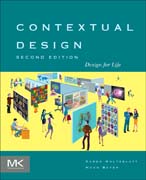
This second edition of the classic Contextual Design describes the core techniques needed to produce a compelling user experience deliberately. Contextual Design was first invented in 1988 to drive a deep understanding of the user into the design process. It has been used in a wide variety of industries and taught in universities all over the world. Until now the basic CD approach has needed little revision. But with the wide adoption of handheld devices, especially smartphones, the way technology is integrated into people's lives has fundamentally changed. Contextual Design V2.0 introduces both the classic CD techniques and the new techniques needed to design for life, fulfilling core human motives while supporting activities. Contextual Design is a user-centered design process that uses in-depth field research to drive innovative design. It is a complete front-end design process rooted in Contextual Inquiry, the widespread, industry-standard field data gathering technique. Contextual Design adds techniques to analyze and present user data, drive ideation from data, design specific product solutions, and iterate those solutions with customers. Given the changes in technology and user expectations of product experience, Contextual Design V2.0 describes each technique, how, why, and when to use it, along with examples to help teams design for the way technology now fits into peoples' lives . This completely updated and revised edition is written in a clear, informal style without excessive jargon - this is the must-have book for any UX Design library. You'll find that it contains coverage of mobile devices and consumer and business products, all illustrated with new examples, case studies, and discussion of how to use CD with agile development and other project requirements methods. Gather detailed data about how people live, work, and use productsDevelop a coherent picture of a whole user population Use the seven Cool Concepts to support core human motives Generate new product concepts guided by user data, ideation techniques, and principles key to producing a compelling user experienceStructure the system and user interface to best support the user across place, time, and platformValidate and iterate your design to hone it for success INDICE: Chapter 1: Introduction Part 1 Gathering User Data Chapter 2: User Data Drives Design Chapter 3: Principles of Contextual Inquiry Chapter 4: The Interpretation Session Part 2 Revealing the World Chapter 5: From Data to Insight: Using CD Models Chapter 6: The Affinity Diagram Chapter 7: Building Experience Models Chapter 8: The Traditional Models Part 3 Reinventing Life Chapter 9: Inventing the Next Product Concept Chapter 10: From Data to Design - The Wall Walk Chapter 11: Ideation - Visioning and the Cool Drilldown Part 4 Designing the System Chapter 12: The Challenge of Product Design Chapter 13: Storyboards Chapter 14: The User Environment Design Chapter 15: UI Design Chapter 16: Prototyping Chapter 17: Conclusion - Into Action
- ISBN: 978-0-12-800894-2
- Editorial: Morgan Kaufmann
- Encuadernacion: Rústica
- Páginas: 608
- Fecha Publicación: 01/11/2016
- Nº Volúmenes: 1
- Idioma: Inglés
